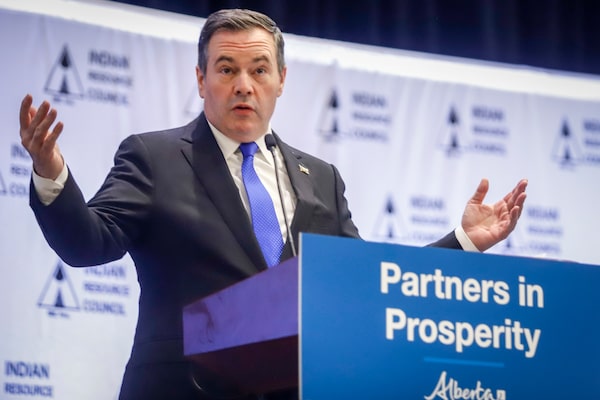
Alberta Premier Jason Kenney delivers remarks at the Major Projects conference in Calgary, on Feb. 26, 2020. His government largely treats taxes as a non-option, instead focusing on spending cuts.Jeff McIntosh/The Canadian Press
In Alberta’s 2020-21 budget, on Page 169, there’s a chart that speaks volumes about the province’s fiscal dilemma.
Albertans, as the graphic titled “Alberta’s Tax Advantage” illustrates, pay the country’s lowest taxes. The chart lays out precisely how much less revenue the provincial government has, compared with other provinces, as a result of those low taxes. And what it shows is that, if Alberta had the tax code of Saskatchewan, British Columbia, Ontario or any other province, it would not currently be running a deficit. Instead, it would have a huge multibillion-dollar surplus.
This is worth remembering as the United Conservative Party government grapples with a wide fiscal gap, which it has chosen to try to bridge with spending cuts and a long-term plan to downsize government. Those are not illegitimate choices, nor has Premier Jason Kenney’s government hidden the fact that this is its road map.
But it is a choice. There are other roads available. And as that chart on Page 169 of last week’s budget points out, one of those roads has been taken by every other province.
Alberta has a long history as a low-tax, high-spending jurisdiction. That equation doesn’t sum in the rest of the country, but it does in Alberta, thanks to oil royalties. Oil allowed Alberta governments to tax like conservatives and spend like social democrats.
For decades, that’s how the province operated, spending 100 per cent of its resource revenues, and sometimes more than 100 per cent, leading to deficits even in boom times.
To bring the equation back into balance, the Kenney government is focusing on spending cuts – while hoping for higher oil prices.
Alberta forecasts 2020-21 revenue of $50-billion, with a deficit of $6.8-billion. Three years from now, bolstered by an optimistic view of oil prices, revenue is supposed to reach $58.1-billion. Combined with spending restraint, the result is supposed to be a $700-million surplus.
But that will only happen if oil prices co-operate, and go up.
The UCP government believes resource revenues will surge to $8.5-billion by 2022-23, up $3.4-billion from 2020-21. Oil is also supposed to fuel higher personal and corporate income taxes, to add another $2.6-billion.
Underlying these numbers is a confident price forecast.
Among private forecasters, the average oil price a barrel in 2021 is US$59. The Alberta government predicts US$62. In 2022, the average private forecast is US$61. Alberta’s is US$63.
A dollar or two a barrel seems like nothing – but each dollar equals $355-million in Alberta’s budget. The gap between private forecasters in 2021 and the province would make for a $1-billion swing.
Alberta’s budget is a bet on everything going right for the province, and oil. Given volatile prices – the West Texas benchmark on Wednesday was around US$47 – that is one big bet. And the UCP’s sunny forecast extends across the economy, with the budget forecasting higher economic growth than the private sector through 2023.
Mr. Kenney’s government may be right. Oil may save Alberta yet again. But if oil falls short, deeper spending cuts are on the horizon.
The cuts are already sizable. Health care spending in 2022-23 will be about 1 per cent lower compared with 2019-20. Factor in a growing population and inflation, and that’s a substantial cut. Education spending will be cut 4 per cent by 2022-23. All told, Alberta plans to cut operating spending by about 2 per cent over the next three years.
These are all legitimate choices, made by an elected government. But spending cuts, and prayers for crude, are not the only options.
As the Alberta budget helpfully points out, if Alberta had the same tax system as Ontario – Canada’s second-lowest tax province – Edmonton would be bringing in an extra $14.4-billion this year. That would leave Alberta with a $7.6-billion budget surplus. If Alberta had Saskatchewan taxes, provincial coffers would take in an extra $15.1-billion. Copying B.C.’s tax system would yield an extra $17.5-billion.
To deal with Alberta’s budget deficit, Mr. Kenney’s government has largely treated higher taxes as a non-option. Instead, it has focused almost exclusively on spending cuts, served on a bed of expectations of higher oil prices.
It just might work, fiscally and politically. But it’s not the only option on the menu.